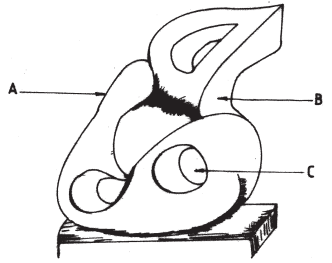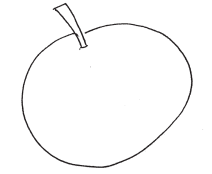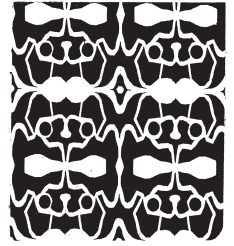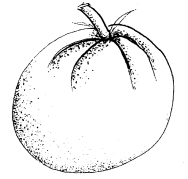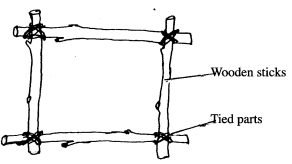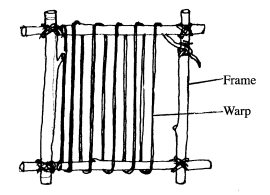SECTION A (20 marks)
Answer all the questions in this section in the spaces provided.
-
- The illustration below represents a sculptural form.
Name the parts marked A, B and C. (3 marks) - What is visual art? (1 mark)
- Differentiate between hue and pigment. (2 marks)
- State two advantages of asymmetrical balance in a composition. (2 marks)
- Explain the role of critique in art. (1 mark)
- Explain the main reason for priming canvas before painting. (1 mark)
- State the four main functions of shape in 2-D artwork. (4 mark)
- Explain the term "Design brief". (1 mark)
- Distinguish between product and communication design. (2 mark)
- Give three reasons why montage is regarded as a kind of collage. (3 marks)
- The illustration below represents a sculptural form.
SECTION B (25 marks)
Answer all the questions in this section in the spaces provided.
- Using the stippling technique, create three dimensional effect on the form below. (4 marks)
- Study the colour chart below and fill in the missing colours. (5 marks)
Red - Orange Yellow Blue - Violet Blue - Green - The illustration below represents a repeat pattern formed from a single motif.
Identify and sketch the motif in the space provided below. (5 marks) - What is meant by the following terms in pottery?
- Stamping (1 mark)
- Burnishing (1 mark)
- Slip trailing (1 mark)
- Incising (1 mark)
- Excising (1 mark)
- The illustration below represents a printing technique.
- Identify the technique. (1 mark)
- In the space provided below, sketch the image as it would appear when printed on a surface. (3 marks)
- Explain what is meant by direct transfer and indirect transfer of ink onto the printing surface in the printing process. (2 marks)
SECTION C (15 marks)
Answer any one question from this section. Write your answer in the space provided after question 9.
- Using two appropriate illustrations for each, explain the meaning of the following terms used in Tie and Dye technique.
- Tritik (5 marks)
- Marbling (5 marks)
- Pleating (5 marks)
- Analyse clay as a material for pottery under the following sub-headings.
- Properties (6 marks)
- Classification (4 marks)
- Bone dry clay (1 mark)
- Leatherhard (1 mark)
- Slip (1 marks)
- Grog (1 marks)
- Greenware (1 marks)
-
- What is a shed as applied in the weaving technique? (1 mark)
- With the help of an appropriate illustration for each, describe the following processes:
- making a dowel loom; (4 marks)
- warping the loom; (4 marks)
- weaving the first four rows of a 2/2 twill weave. (6 marks)

MARKING SCHEME
-
- A -Contour (1 mark)
B - Plane (1 mark)
C - Void (1 mark) - Visual art is a form of expression through which ideas, concepts and experiences are perceived through the sense of sight. (1 mark)
- Hue is a name of a colour while pigment is the colouring matter that gives colour to objects. (2 marks)
-
- It makes the composition interesting, lively and active. (1 mark)
- It creates variety, thus reducing monotony. (1 mark)
- It helps to highlight the areas of weakness and strength for improvement. (1 mark)
- The main reason of priming a canvas before painting is to improve the absorption of paint on the canvas.
(1 mark) -
- Represent objects on a flat surface.
- Suggest movement
- Creates an illusion of space and volume on a flat surface.
- Creates an illusion of depth by overlapping shapes.
- Express mood/feelings/emotions/ideas/imaginations in a composition.
Any 4x1 = (4 marks)
- It is a statement or summary of the clients specification/comprehensive written document for a design project representing the business needs for a design and the designer. (1 mark)
- Product design is concerned with the efficient and effective generation and development of ideas through a process that leads to new products/it involves creating forms for utilitarian purposes. Communication design is concerned with the creation and making of visual forms to convey specific information or message.
(2 marks) -
- Pieces of montage are prepared and stuck in the same way as collage.
- Whole pieces or parts are pasted by juxtaposition (overlaying process) in both.
- Paper is used for both techniques.
- They both need a backing or support.
- They both posses visual variety.
Any 3 x 1 = (3 marks)
- A -Contour (1 mark)
-
Stippling technique 1 mark
Tonal value (lights and dark) 2 marks
3 - Dimensional effect 1 mark
Total = 4 marks -
Filling correct colours 1 x 5 = (5 marks)Red - Orange Red red-violet yellow-green Yellow Yellow - Orange Blue - Violet Blue Blue - Green -
Correct motif (3 marks)
Precision/accuracy (2 marks)
Total = 5 marks -
- Stamping - Designs are created by pressing objects into the moist clay forms. Patterned stamps, wood blocks can be used. (1 mark)
- Burnishing - Firmly rubbing a leatherhard clay form with a smooth material to create a shiny/ sheeny glossy effect. (1 mark)
- Slip-trailing . Applying coloured liquid clay onto the surface of leather hard clay form using a nozzle or a brush.(1 mark)
- Incising - Making shapes by cutting, engraving or carving forms on the clay using a sharp tool. (1 mark)
- Excising - Cutting out or away a part of the clay form in order to decorate it. (1 mark)
Total = 5 marks
-
- Intaglio (1 mark)
-
Correct image (2 marks)
Accuracy (1 mark)
Total = 3 marks - In direct printing, ink is forced through a silk mesh/ organdie on to the printing surface. The image created remains unchanged. For the indirect printing transfer an inked block is stamped/pressed onto the printing surface and the image is in the reverse. (2 marks)
Total = 6 marks
-
-
-
(2 marks)
-
Gathered and tied fabric (2 marks)
In tritik technique, strong thread is used to make running stitches which outline the design/pattern on the fabric. They are then pulled tightly to form gathers and tied before dyeing. (1 mark)
-
-
-
Crumpling the fabric into a ball (2 marks)
-
Crumpled and tied fabric (2 marks)
Ini marbling, the fabric is gathered, crumpled and tied randomly into a ball before dyeing. ( 1 mark)
-
-
Folded pleats (2 marks)
-
Tied pleats (2 marks)
In pleating the fabric is folded 9 vertically) at equal intervals and tied before dyeing. ( 1 mark)
Total = 15 marks
-
-
- The three properties of clay are:
- Plasticity - which refers to the ability of clay to stretch or bend. It may also refer to the elasticity, malleability and pliability of clay. It is this property that makes clay a special material as it can be manipulated into any shape. (2 marks)
- Porosity - refers to the ability of clay to absorb water, air and other fluids. This make it dry without cracking. (2 marks)
- Vitrification - refers to the ability of clay to turn to a glassy substance during firing and become hard and strong material. (2 marks)
- Classification of clay
- Residual/primary clay - pure clay found at its original source of formation. (2 marks)
- Sedimentary/secondary clay - impure clay removed or transported from the place of origin by an agent of erosion and deposited in a new distant position. (2 marks)
- Bone dry clay - is that clay which has lost all moisture, its brittle and ready for firing. (1 mark)
- Leather hard - is the point at which the clay has hardened, it is no longer pliable but can still be decorated using sharp tools. (1 mark)
- Slip - liquid clay that is in paste like consistency used as adhesive for joining and decorating clay articles.
(1 mark) - Grog - Fired clay that has been ground into powder and used for stiffening/thickening of clay to reduce shrinkage. (1 mark)
- Greenware - refers to unfired clay. (1 mark)
Total = 15 marks
- The three properties of clay are:
-
- Shed - is a temporary separation of lower and upper warp yarns which leave a gap/space through which the weft is passed in the weaving process. (1 mark)
-
- Wooden sticks
Illustration of a dowel loom- Measure, mark and cut the dowels according to the required size of the loom.
- Notch all four lengths at their ends so that they lie against each other and tie them across each other at the marked points.
Correct description = (2 marks)
-
Illustration of dowel loom with warps. (2 marks)- Tie the first end of the warp thread to the bottom bar of the dowel loom and take the yarn to the top bar, over it and down again to the bottom bar. Continue warping this way until the whole loom is covered with warp yarns/threads.
Correct description = (2 marks)
- Tie the first end of the warp thread to the bottom bar of the dowel loom and take the yarn to the top bar, over it and down again to the bottom bar. Continue warping this way until the whole loom is covered with warp yarns/threads.
-
Illustration of a twill weave (2 marks)- 1st: row: starting from right to left, insert colour weft under 1. over 2, under 2, over 2, under 2 and over 1.
- 2nd row: from left to right, insert the weft under 2, over 2, under 2, over 2, under 2.
- 3rd row: right to left insert the weft over 1, under 2, over 2, under 2, over 2 and under 1.
- 4th row: left to right and insert the weft over 2, under 2, over 2, under 2 and over 2
Correct description of each row 1 mark = (4 marks) - Note: order of rows may vary from one candidate to another.
Total = 15 marks
- Wooden sticks
Join our whatsapp group for latest updates
Tap Here to Download for 50/-
Get on WhatsApp for 50/-
Download KCSE 2012 Art and Design Paper 1 with Marking Scheme.
Tap Here to Download for 50/-
Get on WhatsApp for 50/-
Why download?
- ✔ To read offline at any time.
- ✔ To Print at your convenience
- ✔ Share Easily with Friends / Students

